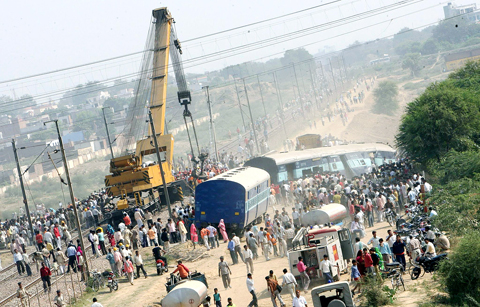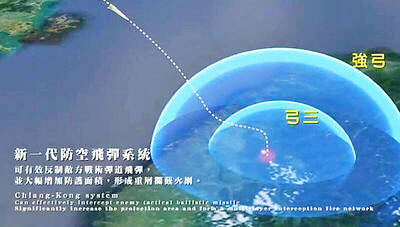A New Delhi-bound Indian express plowed into the back of another passenger train near the Taj Mahal town of Agra early yesterday, killing 22 people and injuring 17, police said.
Senior police officer Vijay Kumar said that 22 people died in the early morning crash on tracks outside the town of Mathura, 50km north of Agra.
“The death toll has risen to 22 and the number of injured is 17,” he said by telephone. “They [the injured] have been admitted to local hospitals.”

PHOTO: EPA
Rescuers, working with mechanical cutters amid a huge crowd of onlookers, battled to free people trapped in the badly mangled carriage that bore the brunt of the collision.
Local railway manager Rajendra Dutt Tripathi said a train traveling from the southern state of Goa to New Delhi had run into the back of the stationary Mewar Express, an overnight service from western Rajasthan to the capital.
The force of the impact was such that the engine of the Goa train ended lodged inside the last carriage of the other express. Bloodied bodies and people were pulled from the wreckage before being ferried to hospitals by ambulance.
Tripathi said initial reports suggested the Mewar Express was at a standstill because a passenger had pulled the emergency chain and the driver of the Goa express had overlooked a signal requesting him to stop.
“These are a matter of investigation and a final conclusion can only be reached after a detailed inquiry,” he said.
The Mehar Express, minus the damaged carriages, was later seen arriving in Delhi as cranes were called in to remove debris from the site of the accident.
“There was a loud bang and we were suddenly thrown out of our seats,” a passenger told the Press Trust of India news agency.
“People and luggage from the upper berths fell on us and there was panic everywhere,” he said.
A resident of Kota in Rajasthan, Saurabh Jain, who was also in the Mewar Express, said rescue teams took more than an hour to arrive.
“The injured were wailing. There was no ambulance to ferry them to the nearest medical centers till about 6:45am,” he told the Press Trust of India.
R.D. Vajpayee, chief spokesman for northern railways, said that the company would pay 500,000 rupees (US$10,800) to the families of the dead. The state-run railway system — still the main form of long-distance travel in India despite fierce competition from new private airlines — carries 18.5 million people daily.
There are 300 accidents on the railways every year. In February, at least 16 people were killed and 60 injured when 12 carriages of a passenger train derailed in eastern India.

LIMITS: While China increases military pressure on Taiwan and expands its use of cognitive warfare, it is unwilling to target tech supply chains, the report said US and Taiwan military officials have warned that the Chinese People’s Liberation Army (PLA) could implement a blockade within “a matter of hours” and need only “minimal conversion time” prior to an attack on Taiwan, a report released on Tuesday by the US Senate’s China Economic and Security Review Commission said. “While there is no indication that China is planning an imminent attack, the United States and its allies and partners can no longer assume that a Taiwan contingency is a distant possibility for which they would have ample time to prepare,” it said. The commission made the comments in its annual

DETERMINATION: Beijing’s actions toward Tokyo have drawn international attention, but would likely bolster regional coordination and defense networks, the report said Japanese Prime Minister Sanae Takaichi’s administration is likely to prioritize security reforms and deterrence in the face of recent “hybrid” threats from China, the National Security Bureau (NSB) said. The bureau made the assessment in a written report to the Legislative Yuan ahead of an oral report and questions-and-answers session at the legislature’s Foreign Affairs and National Defense Committee tomorrow. The key points of Japan’s security reforms would be to reinforce security cooperation with the US, including enhancing defense deployment in the first island chain, pushing forward the integrated command and operations of the Japan Self-Defense Forces and US Forces Japan, as

INTERCEPTION: The 30km test ceiling shows that the CSIST is capable of producing missiles that could stop inbound missiles as they re-enter the atmosphere Recent missile tests by the Chungshan Institute of Science and Technology (CSIST) show that Taiwan’s missiles are capable of intercepting ballistic missiles as they re-enter the atmosphere and pose a significant deterrent to Chinese missile threats, former Hsiung Feng III missile development project chief engineer Chang Cheng (張誠) said yesterday. The military-affiliated institute has been conducting missile tests, believed to be related to Project Chiang Kung (強弓) at Pingtung County’s Jiupeng Military Base, with many tests deviating from past practices of setting restriction zones at “unlimited” and instead clearly stating a 30.48km range, Chang said. “Unlimited” restrictions zones for missile tests is

NO CHANGES: A Japanese spokesperson said that Tokyo remains consistent and open for dialogue, while Beijing has canceled diplomatic engagements A Japanese official blasted China’s claims that Japanese Prime Minister Sanae Takaichi has altered Japan’s position on a Taiwan crisis as “entirely baseless,” calling for more dialogue to stop ties between Asia’s top economies from spiraling. China vowed to take resolute self-defense against Japan if it “dared to intervene militarily in the Taiwan Strait” in a letter delivered Friday to the UN. “I’m aware of this letter,” said Maki Kobayashi, a senior Japanese government spokeswoman. “The claim our country has altered its position is entirely baseless,” she said on the sidelines of the G20 summit in Johannesburg on Saturday. The Chinese Ministry